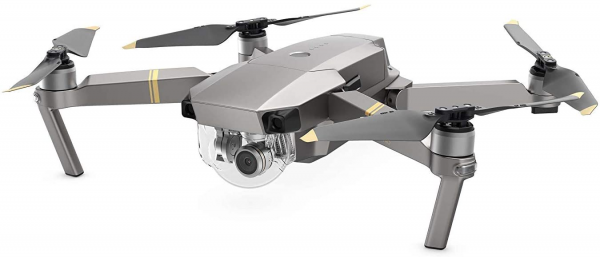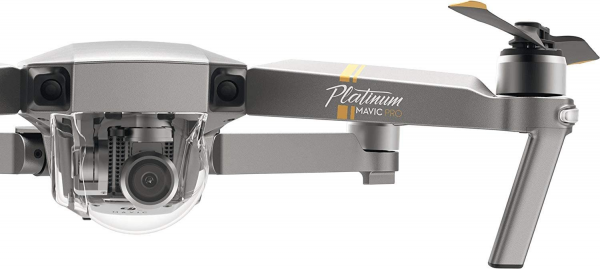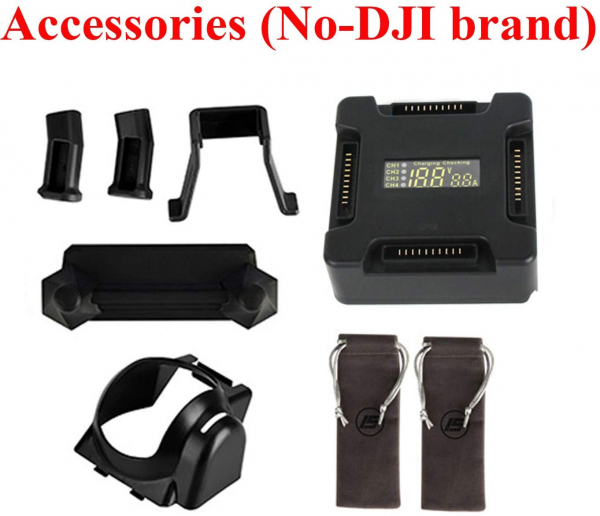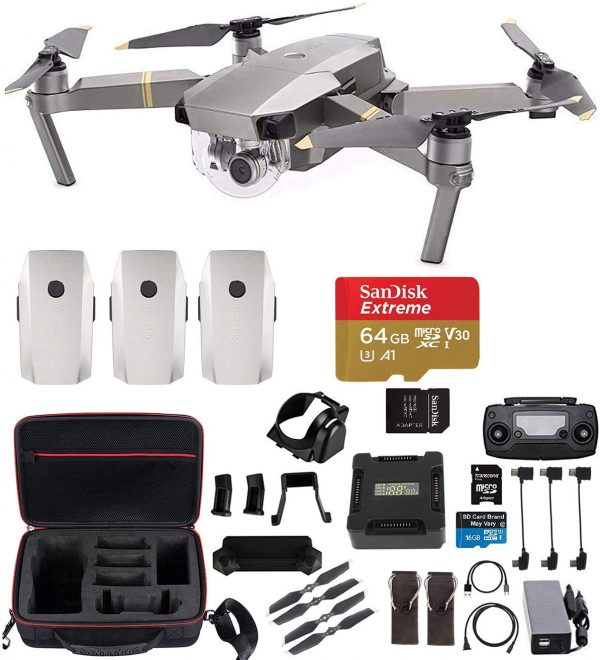DJI
DJI Mavic Pro: the best drone of the moment
Aprox. 1129€ - see price -
See specificationsFor the moment DJI reigns supreme in the world of drones and its latest Mavic Pro is likely to further consolidate its supremacy: 4K camera, fun automated flight modes, obstacle detection and above all a record compactness on this segment. The Mavic Pro is stunning, powerful and intelligent. Admittedly, its price of € 1,199 does not place it within the reach of everyone, but there are many reasons to fall for it. Follow us, we take you flying so that you can better understand our enthusiasm.
Positive points
Construction.
Foldable and compact.
Efficient and versatile.
Stabilization.
Good image quality.
Many relevant autonomous flight modes.
Obstacle detection and avoidance.
Our favorite of the year 2016!
Bad points
Autonomy could be even better.
Shadows of the propellers in the image when there is a lateral light source.
High price at launch.
Our review
Presentation
At the beginning of October, DJI presented to the press its latest addition, the Mavic Pro, and we had the chance to take a quick start with this new generation drone. Our first impressions being very positive, we were eager to push the experiment further to find out if the Mavic Pro could finally take the market leadership.

Getting started
The Mavic Pro has a rare advantage: it folds back on itself and can be stored in just about any bag. Do you think this applies to any RTF drone and that you only need a backpack to carry one? Lost! We have written "any bag", which means that a classic backpack, a photo bag, a city bag, or even a large handbag can carry the Mavic Pro. Suddenly, this drone changes the situation: it is no longer a question of wondering if we can take it with us or not, we can in most cases. Of course, there are small drones, "dronies", like the Yuneec Breeze 4K, but whose performance or qualities are sacrificed on the altar of compactness. This is not the case with the Mavic Pro which has nothing to envy to the more imposing drones, on the contrary. Here, the finish is excellent and in accordance with our first impressions. The manufacturing is top of the range, the construction is serious and the materials used inspire confidence.
When folded, its dimensions of 19.9 x 8.3 x 8.3 cm (L x W x H) give it a footprint equivalent to that of a small telephoto lens like the Canon 70-200 mm f / 4. With all arms outstretched, it fits into a 24 cm square, which surprisingly makes it even more compact than a Parrot Bebop 2, which measures 28 x 32 cm. Except that here, the list of technical characteristics seems endless and above all we are entitled to a UHD 4K 30p and 4K 24p Cine camera mounted on a stabilized 3-axis gimbal. The latter is equipped with a 1 / 2.3 inch CMOS sensor for 12.35 effective Mpx and a field angle of 78.8 °, or a wide-angle equivalent of 28 mm in full frame; small additional refinement, it is possible to take the point between 0.5 m and infinity.
In addition to the classic "Return to Home" or "Follow me" modes, the Mavic Pro is able, like the Phantom 4, to follow a subject by 3D recognition, to go to a given point by simple tapping on the screen (" Tapfly ") or to follow a predefined path automatically, but also to take a photo in" Selfie "mode with a simple gesture of the arms, or to bypass and avoid obstacles automatically. Finally, note that the 4 brushless motors can propel the Mavic Pro at a maximum speed of 65 km / h in Sport mode and officially fly for 27 minutes.
The Mavic Pro remote control is also a good surprise. Not only is it very compact, but it is also the first time that a controller from the Chinese manufacturer has integrated a telemetric information screen on which we can check the height, flight modes, GPS connection, speed, transmission signal strength or the battery level . Icing on the cake, transmission by OccuSync allows HD return up to 7 km!
Finally, a word about the application, already known to our services since it is the same as for the Phantom 4. It is very complete, but too loaded and the information is redundant with the controller. We would like to find the equivalent of a "Display" button. Note, however, that for the first time too, it is possible to control a manufacturer's drone via a smartphone. However, the maximum transmission distance will drop to 80 m, the height will be limited to 50 m and the speed to 14 km / h. It's not much, but it can help.

Flight
The flying experience with the Mavic is really very satisfying and its belonging to the RTF category is not usurped. It is enough to unfold the upper arms, then the lower arms so that the drone is ready to take off. The landing pads are directly integrated into the arms and the very low rear ground clearance, barely an inch, gives a slightly sloping body line, which gives the Mavic a definite sleek look, even when stationary. We are very far from the octopus silhouette of the Phantom 4. It is also not necessary to unfold the propellers, since the centrifugal force is sufficient to position them well when the engines are launched.
The ignition procedure is fairly standard. We start by turning on the remote control, then the drone by pressing the button on the back of the battery (a short press followed by a long press). DJI provides USB cables to its customers, one for connecting an Android smartphone, the other for an iPhone. When we got started, the compatibility between the remote control and an Android smartphone was not guaranteed; a problem now solved since we did not encounter any problem of connection with our Huawei P9.
Once the pairing has been carried out and the acquisition of the GPS validated (very fast, by the way), we arrive at the main interface of the application. The user therefore has two choices: take off or go through the different settings. The application, a real dashboard for the drone, offers a multitude of personalization choices ranging from adjustment and reaction speed of commands to calibration of the gimbal, via the possibility of activating the Obstacle Avoidance or altitude. and the maximum distance.
The engines are launched simply by pulling the joysticks diagonally towards you or simply by pressing the icon located at the top left of the screen. The Mavic Pro then rises 2 m from the ground and awaits orders.
In Normal mode, the Mavic Pro is reactive and precise. By activating the Sport mode, you gain a lot of nervousness and responsiveness of the controls. We will not compare the Mavic Pro to a racer, but there is more than enough to have fun since we can achieve peaks up to 65 km / h, fly close to the ground or play drifts with precision. For domestic flight, it is possible to activate an astonishing and useful Tripod mode, which allows to substantially lower the nervousness of the Mavic Pro and to benefit from a much finer piloting. In addition, the Mavic is equipped with 5 cameras, GPS + Glonasss, two ultrasonic sensors and two redundant sensors which not only provide it with stability making it possible to fight against winds of more than 38 km / h, but also the possibility of see and avoid obstacles up to a distance of 15 m.
In the still dense foliage of the forest where the test took place, the Mavic was able to avoid the largest branches. Be careful however, the Obstacle Avoidance only works from the front, so beware in case of side tracking.

Image quality
Example of photo at ISO 100.
The image quality of the Mavic Pro is very similar to that of the Phantom 4, with the difference that the angle of field of the camera of the latter is wider (20 mm against 28 mm on the Mavic). However, the behavior of the camera is very close. In photo, the image is very clear in the center, with a rendering of details very sufficient in the lowest sensitivities of ISO 100 to 400, but with an endemic softness at the edges and corners of the image. Above ISO 400, the noise quickly becomes very excessive, but the Raw format allows you to still use a file at ISO 1600.
Raw at ISO 1600.
Depending on your level of requirement, the image will be usable for publication on networks, but beware in case of printing, the details are really too smoothed after ISO 400, especially in JPEG. On the other hand we did not note chromatic aberrations on our files, the vignetting is well managed, the distortion is weak and the dynamics in photo are acceptable.
4K UHD video clip.
On the other hand, in video, the dynamics are shorter and swarming in the shadows is visible from the lowest sensitivities. However, for general public use, the average user will be delighted with the qualities of this camera, especially since the UHD / 4K files make it possible to obtain a very sharp and flattering rendering of the landscapes. The colorimetry is also pleasant, without excess, and especially the gimbal ensures an excellent work of stabilization. Although there are some jerks in the most abrupt movements of the pilot, the picture is generally very stable.
HDTV 1080 video extract
In 1080 / 60p, the rendering of the details did not seem breathtaking either. But its biggest fault is in the positioning of the camera relative to the propellers: with a light source located between 45 and 90 ° from the drone, streaks appear in the image; it is in fact the shadows of the rotating propellers that heal the image. A point that will have to be taken into account during a capture. Finally, note that the most knowledgeable will be free to immerse themselves in the meanders of post-production with the possibility of activating an Art, Cinelike or S-Log image style for more editing latitude.
1080p video editing:
4K video editing:
Finally, note that one of the peculiarities of the Mavic's camera is that it has an autofocus allowing to focus on a subject located between 0.5 m and infinity. So be careful to properly focus between takeoff and a flight, because the focus distance may vary if you forget to adjust it or if you accidentally press the screen. We regret that there is no option to lock it permanently on infinity.
Ultimately, if the image is not excellent and still has many imperfections, especially in terms of noise and smoothing beyond 400 ISO, it remains very sufficient for leisure use or even for a pro who would need to carry out aerial plans without having to deploy a heavy and bulky aerial device.

Autonomy
The Mavic Pro is equipped with a Lipo 3S 11.4 V battery for 3,830 mAh promising 27 minutes of autonomy at a constant speed of 27 km / h without wind, 24 minutes in hovering and a flight time average of 21 minutes. In fact, we managed to fly at best almost 23 minutes by filming constantly in 4K with a wind of less than 10 km / h (Spain weather data) and a forced landing with a remainder of 10% of autonomy. Except for the Parrot Disco (the test of which is in progress) which allows a flight time of almost 45 minutes, the Mavic Pro is the drone which has the best autonomy among those we have tested. An appreciable point, especially since the charging time is relatively fast with 60% of capacity recovered in 40 minutes and a full battery in 1h15. However, since the regulations oblige to fly in open areas (logical!) And it is imperative to leave the cities to fly (except professional use under prefectural authorization only), we can only recommend that you purchase at least an additional battery.
Conclusion
The Mavic Pro is one of our favorites in 2016. Not only does its autonomous flight modes and its overall performance make it versatile and relatively enduring, but the kinetics of its foldable arms also allow it to be transported everywhere, all the time. If its price (€ 1,199 at launch) does not place it within the reach of all budgets, its use goes beyond the simple framework of leisure and truly falls into the category of landscape shooting tools. A safe bet for all lovers of images and model aircraft, although it is now surpassed by the Mavic 2 Zoom and Mavic 2 Pro, the first being video oriented when the second is better in photo.
Specifications
Reviews


I decided to give a try outdoor because of nice weather. I immediately fell in love with Mavic ...
I purchased the Mavic pro fly more combo as Christmas gift, but the box was open by mistake very unfortunately / luckily. I decided to give a try outdoor because of nice weather.
I immediately fell in love with Mavic - the drone itself is small, as small as 16 oz water bottle. This bundle has 3 batteries, one charging hub, and one nice professional case and some other useful accessories. I carried everything in the bag to a park close by. I am deeply impressed. Although a small drone, it has a high quality camera that captures 4k / 1080p footage. I used both iPhone and iPad mini to connect the drone, and I would highly recommend to use an iPad mini instead of an iPhone. You can preview the photography in real time via your iPad. The drone has a lot functions, which needs more time to explore. Mavic will ruin my whole holiday, and I am going to spend all my holiday with it.
Fantastic package – it has everything you need for Mavic ...
Fantastic package - it has everything you need for Mavic Pro. 3 batteries, 4 battery charging hub, carrying case…. The carrying case is really nice, compact, and lightweight, can hold everything in the bag, and also protect the drone well. I am not sure whether the case is waterproof or not, but I doubt it.
Delivery was fast, great seller, great product.
What a great hobby. I have 2 P4 's and a ...
Exc. Quality; What a great hobby. I have 2 P4 's and a P4Pro, just got the Mavic Pro. Love. it. Many new features. Compact for travel.
Accurate order process and workflow
This is number three video platform in as many weeks. 3rd time is the charm. Most inane conversation with Amazon CS but everything arrived in good order.